July 18, 2025
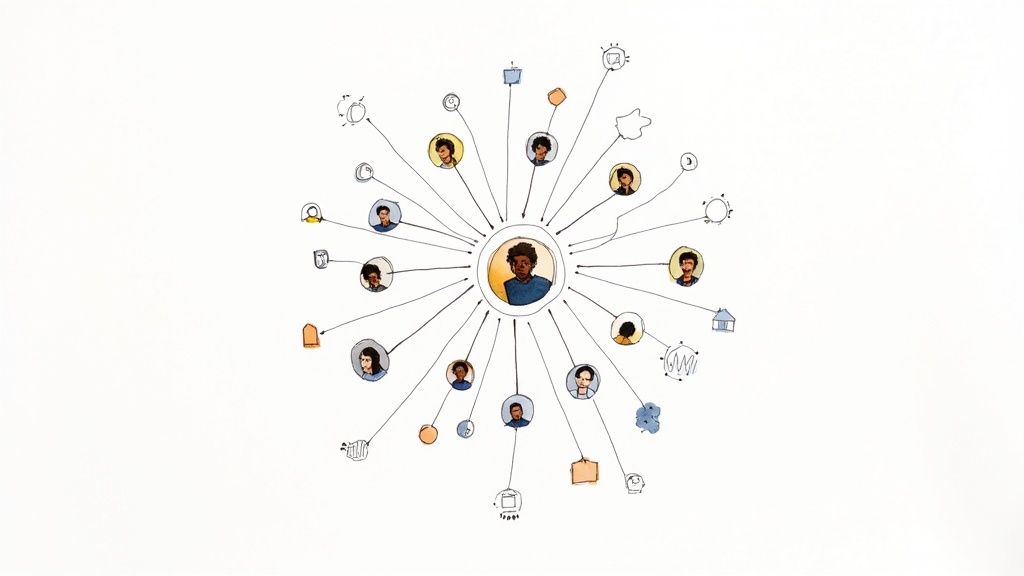
Before you invite a single person or post your first piece of content, the most critical work happens: laying the foundation. A thriving community isn't just a group of people in the same digital space; it's a living ecosystem built on a shared purpose. Getting this right from the start is the difference between a ghost town and a bustling, self-sustaining hub.
This initial planning is your North Star. It guides every decision you'll make, from the kind of conversations you encourage to the features you'll need on your platform.
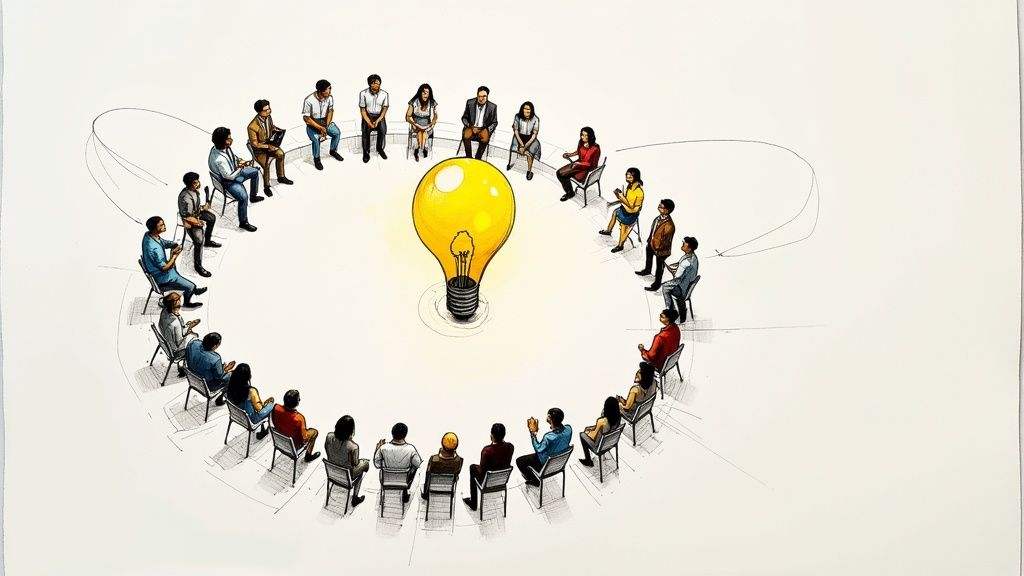
Every great community begins with a compelling "why." This core purpose is the magnet that draws people in and, more importantly, makes them want to stay. Without a clear mission, your community will feel directionless, and members won't know why they should invest their time and energy.
This isn't just fluffy, feel-good stuff; it's a strategic imperative with real business impact. The community management market is expected to balloon to $4.5 billion by 2024 for a reason. And consider this: brands with active online communities enjoy 53% higher customer retention. A strong purpose directly translates to a stronger bottom line.
Your mission statement is your elevator pitch. It needs to be a short, sharp declaration of why you exist. Forget vague goals like "a place for professionals to connect." That tells me nothing.
Let's look at the difference:
See the difference? The second one is incredibly clear. It tells you exactly who it’s for, what they’ll get out of it, and what they’re expected to do. It sets a powerful expectation right away.
A great mission statement is a filter. It actively attracts the right people while gently signaling to the wrong people that this might not be the place for them. This self-selection is crucial for building a high-quality member base from day one.
With a clear mission, you can now paint a detailed picture of the person you're building this for. Go deeper than just job titles and company size. You need to understand their inner world—their motivations, their biggest headaches, and what keeps them up at night.
Start by asking some probing questions:
The more intimately you know this person, the easier it will be to create content, spark conversations, and design events that feel like they were made just for them. For a deeper dive, our guide on community building strategies can help you flesh this out even more.
To bring it all together, here’s a quick checklist to guide your initial planning.
This table summarizes the foundational questions you must answer before you go any further. Nailing these down will save you countless hours and prevent major headaches down the road.
Getting these four pillars right is non-negotiable. They form the bedrock upon which you'll build everything else.
Finally, let's talk about the vibe. Your community's culture is its personality. Is it going to be a high-energy, fast-paced space for breaking news, or a more thoughtful, reflective environment for deep discussions? Deciding this early on is key.
This cultural vision informs your community guidelines. Think of these not as a list of restrictive "don'ts," but as a framework for positive and productive interactions.
Good guidelines should clearly cover:
By establishing a cultural blueprint and clear guidelines from the outset, you're not just preventing problems—you're actively designing a community that is safe, welcoming, and built for long-term success.
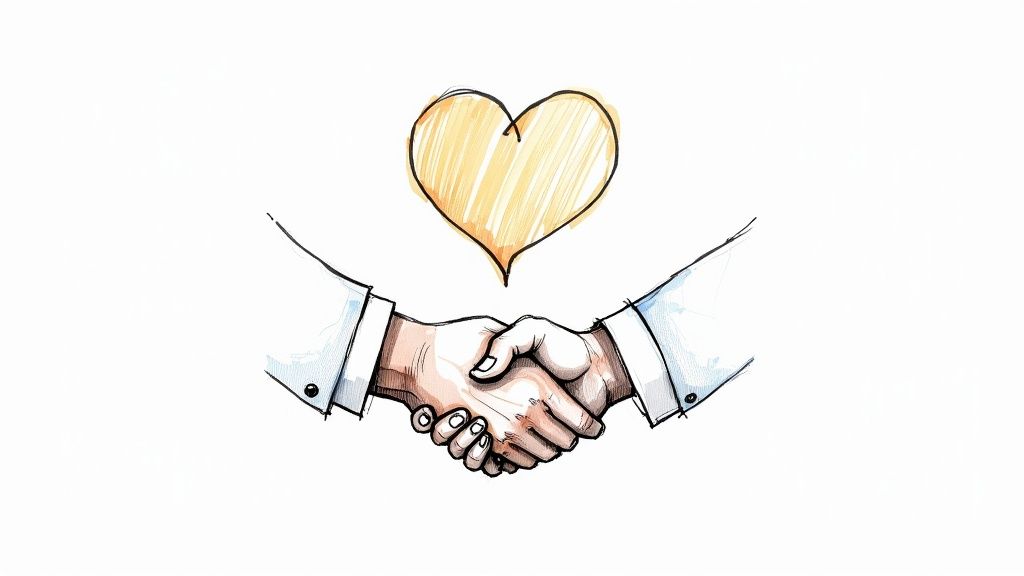
Okay, you've got your purpose nailed down and you know exactly who you want to serve. Now comes the real test: getting people in the door. But we're not just trying to fill seats here. The goal is to recruit your founding members—the people who will become the very architects of your community's culture.
These first 100 members are your spark plugs. They’re the ones who will set the tone, ignite the first conversations, and make the whole space feel alive from day one.
The good news? You don't need a huge marketing budget to find them. Your most powerful recruitment tool is the audience you already have, no matter how small. Think about your email list, your social media followers, and even your professional contacts. These people already know you, trust you, and are primed to hear about what you're building next.
This first wave of outreach has to feel special, not like another email blast. Frame it as an exclusive opportunity to build something new with you.
Forget the generic "Join my new community!" pleas. Your invitation needs to feel personal and highlight the unique value of being a founder. You're asking them to co-create, and your language has to reflect that partnership.
Here’s an approach I’ve seen work wonders for emails to your most engaged contacts:
"I’m building something new—a private space for [ideal member persona] to [achieve core mission]—and your insights on [specific topic] would be invaluable. I'm personally inviting a small, hand-picked group to be founding members, and I immediately thought of you. As a founder, you'll help shape our direction and get direct access to [exclusive benefit]. Would you be interested in being part of this?"
This works because it's not just an ask; it's a compliment. You’re showing them you value their specific expertise and are offering them a seat at the table. That small shift in framing makes all the difference.
Let's be honest: people are drawn to things that are new, exciting, and a little hard to get. You can tap into this natural human tendency by introducing some strategic scarcity into your launch.
Here are a few tactics that really move the needle:
This isn't about being manipulative. It's about signaling that this is a special, one-time chance to get in on the ground floor, which is especially critical when you don't have a bustling, active community to show off yet. The promise of founder status is the initial draw.
The incredible scale of digital access today makes this approach more potent than ever. As of early 2025, the number of global internet users has soared past 5.56 billion, a figure that now surpasses the audience for traditional TV. This means your potential member pool is massive, and using exclusivity is how you cut through the noise to find the most dedicated people. You can dive deeper into how global connectivity is changing engagement by exploring the full 2025 digital overview report.
By blending personalized outreach with exclusive, time-sensitive offers, you create a powerful pull that attracts members who are invested co-creators, not just passive consumers. These are the people who will bring the energy and feedback you need to make your community thrive right from the start.
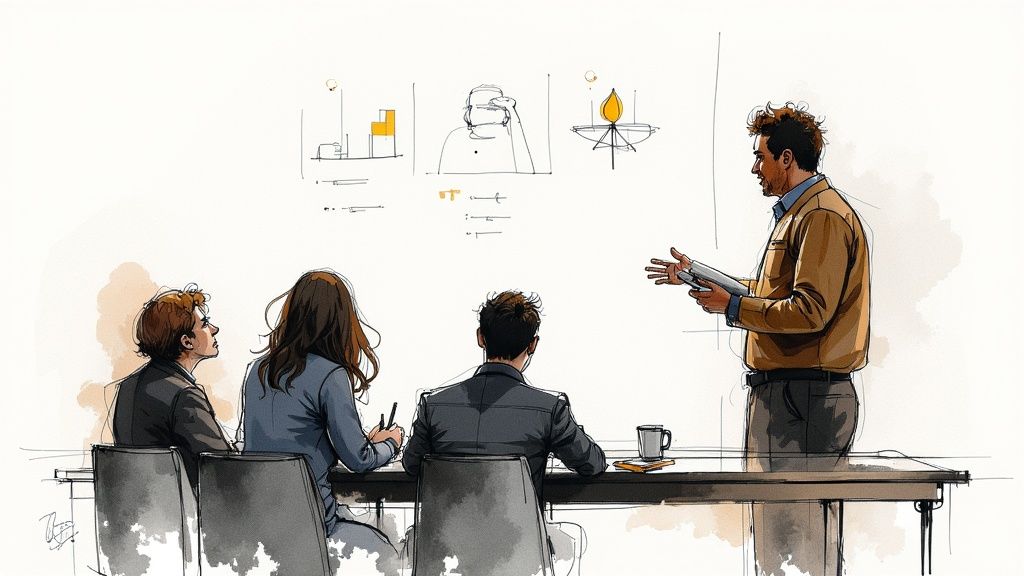
Alright, your founding members are in the door. Now the real fun—and the real work—begins. A quiet community is a dying one, so your mission is to transform those passive observers into active participants who genuinely feel like they belong.
This doesn't just happen on its own. It's all about creating a deliberate, multi-layered engagement strategy. After all, real connection is forged through shared experiences and great conversations. Simply throwing everyone into a chat channel and hoping for the best is a recipe for silence. You have to be the one to light the initial spark.
Every community manager knows the terror of "crickets." The key to avoiding that deafening silence is making it ridiculously easy for people to post for the first time. Broad, open-ended questions like, "What's on your mind?" can feel intimidating. You need to be more specific.
Here are a few tactics I’ve seen work wonders:
These prompts work because they have a low barrier to entry and connect directly to why people joined in the first place. They invite people in without asking for a huge commitment.
Your community space should be more than just a chat room; it needs to be the go-to library for your members' niche. A well-organized content hub is one of the most powerful ways to show your community's value and keep people coming back.
With a platform like GroupOS, you can build a dedicated home for all your valuable resources.

As you can see, you can neatly pull together articles, videos, and discussions into one clean, accessible space. This structure turns scattered posts into a permanent knowledge base, making it easy for members to find what they need and inspiring them to add their own wisdom to the mix.
A great content hub does two things at once: it solves a member's immediate problem and gives them a natural reason to talk with each other about the content. The conversation becomes just as valuable as the resource itself.
I’m also seeing a major shift away from just consuming content. The future is in 'scenius communities,' which are all about active co-creation. Think of them as dynamic labs where members build projects, develop tools, and produce knowledge together. As creating things solo gets easier, this kind of communal creativity is what will set truly special groups apart.
While daily conversations are the steady heartbeat of your community, live events are the adrenaline shots. They create peaks of energy and turn digital avatars into real people, forging much stronger bonds. The trick is to make them interactive—not just another passive webinar.
Here are a few event ideas that consistently drive great engagement:
These events deliver concentrated bursts of value and create shared memories that strengthen the fabric of your community. For a complete playbook, you should definitely check out our deep dive on powerful community engagement strategies.
Ultimately, building a thriving community is about orchestrating opportunities for connection. By combining thoughtful conversation starters, a rich content hub, and engaging events, you create a self-sustaining ecosystem where members don't just show up—they show up to contribute.
When your community is just starting out, that personal, hands-on touch is everything. You can reply to every comment, track members in a simple spreadsheet, and manage events with a few emails. It works.
But what happens when your community explodes from a cozy group of 50 to a bustling hub of 500 or 5,000? That same manual approach quickly becomes your biggest bottleneck. It's simply not sustainable. This is the exact moment when technology shifts from a "nice-to-have" to an absolute necessity for survival and growth.
The right platform doesn’t just help you keep up; it empowers you to be a more strategic leader. By automating the repetitive, time-consuming tasks, you free yourself to focus on what truly matters: sparking real connections and delivering incredible value to your members. Think of a dedicated platform like GroupOS as your central command center, pulling all the scattered pieces of your community into one manageable place.
Let's be honest: juggling member info, content, event sign-ups, and conversations across five different apps is a recipe for disaster. It’s messy, inefficient, and drains your energy. A unified dashboard is the antidote to this chaos, giving you a clear, single-glance view of your community's health.
This isn't just about convenience. A centralized hub allows you to:
The result? Less time spent frantically switching between browser tabs and more time invested in the strategic work that actually fuels your community's growth.
One of the biggest breakthroughs a dedicated community platform offers is access to real, actionable data. You can finally stop guessing what your members want and start seeing what they actually do. Platforms with built-in analytics are a game-changer for truly understanding engagement.
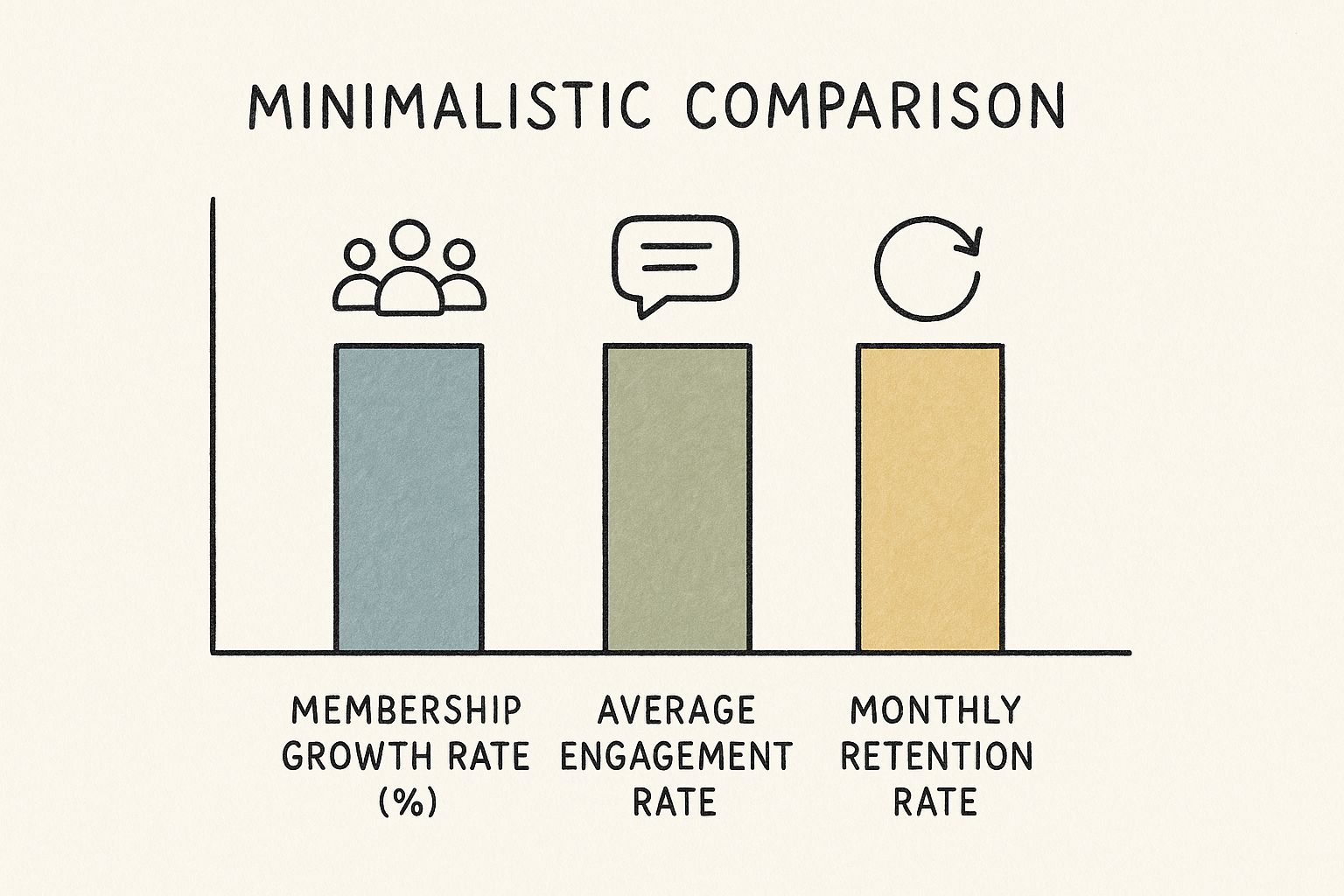
A dashboard like this gives you a real-time pulse on your community, letting you move beyond hollow "vanity metrics" like the total member count. You can start answering the questions that are crucial for long-term health and sustainability.
With solid analytics, you can uncover vital trends:
The image below shows how these core metrics—membership growth, member engagement, and long-term retention—are all interconnected. They are the three pillars that support a thriving, sustainable community.

The visualization really drives home the point that you can't have one without the others. Healthy growth is a direct result of keeping current members engaged, which in turn leads to better retention.
Data is just a collection of numbers until you do something with it. The true magic of community analytics is using them to make smarter decisions and prove the value of your work to any stakeholders.
Your community data is a storybook. It tells you who your heroes are (your top contributors), what your audience craves (your most popular content), and where the plot is thickening (your fastest-growing discussion topics). Your job is to read the story and write the next chapter.
For instance, if your data shows that "Ask Me Anything" (AMA) sessions get three times more engagement than your standard webinars, the path forward is clear: schedule more AMAs! If you see a small group of members consistently answering questions in a specific channel, you have a pre-vetted list of potential moderators to reach out to.
Technology provides the proof, turning your gut feelings into undeniable facts and empowering you to build a more responsive and rewarding community experience for everyone.
As your community evolves, its needs change. The tools that were essential on day one might take a backseat to more advanced features later on. Here’s a look at how a platform like GroupOS supports you at every step of the journey.
This table illustrates how a flexible platform adapts with you. By matching the right feature to the right challenge, you can navigate each stage of community growth with confidence and the right tools at your fingertips.
Let's be real: running a high-value community takes work. As your group expands, you’ll find yourself needing better software, more of your own time, and maybe even some help. Thinking about monetization isn't about squeezing money from your members. It's about building a self-sustaining engine that lets you pour even more value back into the community everyone loves.
The secret? Just be upfront about it. Your members are sharp; they’ll get behind you if they understand why you're charging for certain things. When you clearly explain how revenue from memberships or events will be used to improve the community, it stops feeling like a transaction. Instead, it becomes a shared investment in the future you're all building together.
One of the most straightforward and effective ways to bring in revenue is with a tiered membership model. This lets you keep a free, welcoming front door for everyone while offering something extra for your most dedicated members. The concept is simple but incredibly powerful: everyone gets value, but those who want to go deeper can choose to do so.
A classic setup usually includes:
Your goal is to make the free tier so good that people are thrilled to be there, while making the premium tier an absolute no-brainer for anyone ready to level up. For a more detailed look at this, you can learn how to approach strategic content monetization in a way that truly serves your audience.
Beyond the steady income from memberships, events are a fantastic way to generate revenue while delivering a burst of concentrated value. They create a ton of energy, forge stronger bonds between members, and can be a serious boost to your bottom line.
Using a platform with ticketing built right in, like GroupOS, makes the whole process ridiculously smooth.
When your ticketing is integrated, you can spin up paid workshops, multi-day virtual conferences, or exclusive AMAs without duct-taping three different tools together. It keeps the entire experience professional and contained right within the community home.
Here are a few event ideas that almost always work well:
When you charge for an event, you're not just selling a ticket; you're making a promise of quality. Members who pay are more invested. They show up, they participate, and they take the material seriously, which lifts the energy and the outcome for everyone.
The single biggest pitfall with monetization is creating a "two-class" system where your free members feel like second-class citizens. You have to avoid this at all costs if you want your community to have a long, healthy life. The free experience must always be genuinely valuable on its own.
Never forget that your free members are your future brand ambassadors, your potential premium subscribers, and a critical source of the daily chatter that makes a community feel alive. Alienating them for a quick buck is a surefire way to kill your group's vibe. Make sure the heart of your community—the main forums and the general spirit of camaraderie—is open to everyone.
Think of monetization not as a wall, but as a series of doors. The free community is the bustling, welcoming lobby. For those who want the VIP tour, premium memberships and paid events are simply the keys that unlock those other rooms. This way, your community can thrive financially without ever losing its soul.
Jumping into the world of community building always brings up a ton of questions. As you go from a bright idea to the day-to-day work of managing your group, you're bound to hit some roadblocks and have moments of "am I doing this right?" Here are some straightforward, no-fluff answers to the questions we get asked most often.
Let's get one thing straight: there’s no "on" switch for a vibrant community. While you can definitely get your first members in the door within a few weeks, creating a space where conversations flow freely and members truly connect is a long-term play. Realistically, you should expect it to take 6 to 12 months of dedicated, consistent effort.
In the beginning, it's all you. You’ll be the one starting discussions, welcoming every single new person by name, and creating the content that gets the ball rolling. But as you build trust and people start forming their own bonds, you'll feel a gradual but incredible shift. Members will start answering each other's questions and sharing their own wins. The real measure of success isn't just your member count; it's the quality of the interactions happening without your direct involvement.
I always tell people to think of it like planting a garden. The first few months are all about tilling the soil, planting the seeds, and watering diligently. It’s only after that sustained care that the garden really starts to thrive, with new sprouts popping up all on their own.
I've seen so many enthusiastic founders stumble over the same few hurdles. Knowing what they are from the get-go can save you a ton of headaches down the road.
The mistakes I see most often are:
Another classic blunder is trying to be on every platform at once. Spreading yourself thin across Discord, Slack, a Facebook Group, and a forum just fragments your energy. Pick one central hub for your community and focus on making that one place amazing.
When you get a group of passionate people together, disagreements are not a matter of if, but when. The goal isn't to eliminate conflict entirely—that's impossible. It's about managing it in a way that’s healthy and constructive. Your best defense here is a good offense: have crystal-clear community guidelines from day one.
When a dispute pops up, your job is to be the calm, impartial moderator. Step in quickly, but pull the conversation into a private message or channel whenever you can. Trying to hash it out in a public forum often fuels the fire and makes people dig in their heels.
Gently guide the conversation back to your guidelines, focusing on the specific behavior, not attacking the person. The end goal is always to de-escalate the situation and find a path forward that protects the safety of the space and reinforces what your community stands for.
Ready to build, manage, and scale your community without the chaos? GroupOS provides all the tools you need in one place, from ticketing and content hubs to analytics and member management. Start your free trial and see how easy it is to create a thriving community.


